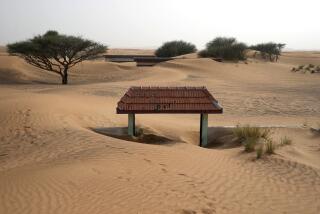Egypt’s Nubians Are a Forgotten People
- Share via
ABU SIMBEL, Egypt — Dislocated and disinherited, Egypt’s Nubians have become a forgotten people.
Flooded out of their ancestral homes almost 30 years ago to make room for the Aswan Dam, they now eke out a living in desert villages far away. Their houses are set in long concrete rows along sandy streets, the harsh landscape unbroken by greenery.
Many young men have left to work in Cairo and women in long black dresses and scarfs, their faces prematurely aged, sit outside with their children in the near-deserted streets.
They dream of their old villages next to the Nile where mud houses, palm trees and green cultivated terraces ran down to the river. Their new villages, about 190 miles to the north, have kept only the names.
They dream of traditions handed down, some say since the beginning of time, when, like the Egyptians, the Nubians created one of the earliest civilizations. In Pharaonic times, the Nubians had their own kingdom that stretched north into Egypt and south into Sudan.
Mohammed Bashir, a Nubian and director of the State Information Service in the town of Aswan, believes they are the oldest people in the world.
To him, the history of mankind started along the Nile. He says Stone Age remains found in Nubian villages and the simplicity of the Nubian language proves that they are an ancient people.
Their descendants, whose complexions are a shade darker than those of other Egyptians, still speak Nubian languages. They were peasant farmers little affected by the 20th Century until the early 1960s, when the Aswan High Dam was built.
A dream of former President Gamal Abdel Nasser, the dam was built to supply the country with electricity and prevent annual floods along the Nile. A huge reservoir, named Lake Nasser, was created behind it.
At the time, an international campaign was launched to rescue Nubia’s Pharaonic remains, including the Temple of Abu Simbel and the Temple of Philae, which were moved above the flood waters. But the villages around the temples were lost, and some 50,000 people were moved north to new desert homes.
“Gamal Abdel Nasser came to Abu Simbel and made a speech. And he asked the Nubians what they wanted. They told him we would like to be near the Nile,” recalled Abdel-Rahman Hassan Gabr, a wizened old man in white robes and a white turban.
“They told us: ‘We know how you live and you will go to a village which is like where you live, only better,’ ” he added.
When they arrived, the Nubians found that their new homes were half-built, without roofs and far from the river.
Many people died from snake and scorpion bites. Some returned to their old villages to find only the tops of the palm trees above the water.
“It was a shock. It was a big shock,” Gabr said.
“I didn’t believe a place like this could exist, a village with no greenery,” an old woman said.
Thirty years later, the Nubians, who number 100,000 in Egypt, have painstakingly recreated a kind of life, painting their houses and setting up seats outside for their traditional street life. They have resumed making their own Nubian bread, after years of relying on government-subsidized bread.
Nowadays, some young men prefer to stay in the villages rather than join the teeming millions in Cairo. They have begun to invest in animals and farming.
But they remain torn between the rival pulls of tradition and modern city life. They do not know whether to teach their children Arabic or Nubian.
Many wonder if they should return to the shores of Lake Nasser to build new villages there, as Nubians from other villages have done.
“The people who live here would like to go back to live near the Nile,” said Gabr.
“But we would have to leave this village, which is part of our lives too. They are willing to go there, but here is also a part of us. This is my home also.”
More to Read
Sign up for Essential California
The most important California stories and recommendations in your inbox every morning.
You may occasionally receive promotional content from the Los Angeles Times.











